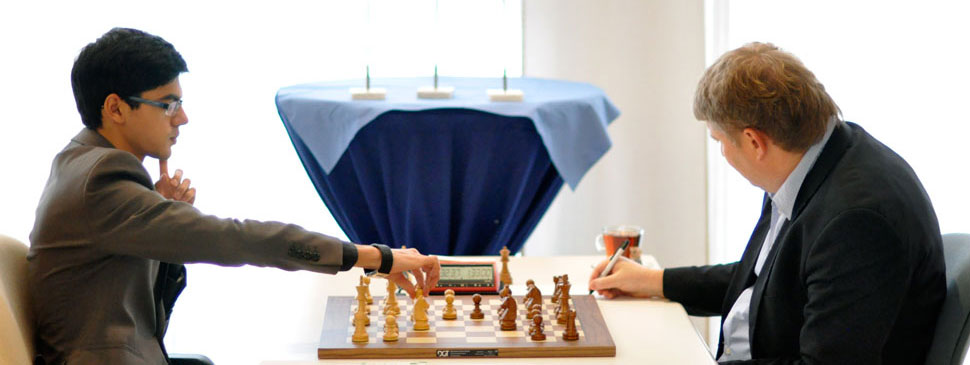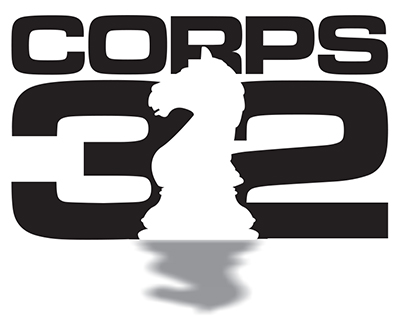Again two draws, and again they were certainly not boring. This time the ‘runners-up’ Jan Timman and Alexey Shirov were in a considerably better mood when they left the playing hall than two days ago. Timman had quickly obtained an advantage with black and forced Jobava to defend himself with subtle manoeuvres – which he did. The elegant defence in the other game came from Shirov, who averted a new drama with a sensational saving combination against Anish Giri.
Timman spoke of ‘a hard and interesting fight’. He’s still trailing by one point, but he was encouraged in a chat with Jan Gustafsson and Paco Vallejo from Chess24: ‘Except for that one loss you’ve been dictating all the games.’ Timman has been trailing before in matches. ‘Against Portisch I won the last two games. That would be a little too much to ask now, but if I can draw even I will be satisfied.’
Today, in any case, Timman showed again that he had prepared well for his unpredictable opponent.
Jobava - Timman
1.e4 e5 2.Pf3 Pc6 3.Lc4 Lc5 4.c3 Pf6 5.d4 exd4 6.e5 d5 7.Le2

One of Jobava’s specialties; he played this against Karjakin, amongst others. Timman got the position earlier this year against Naiditsch. Instead of the common 7...Pe4 Timman now came up with an interesting novelty:
7...d3!?
If White takes everything is fine for Black: 8.Bxd3 Ng4! 9.0–0 0–0 (9...Ncxe5!?) 10.Bf4 Re8! 11.Qe2?! (11.Bb5) 11...f6 and White is in trouble.
8.exf6 dxe2 9.Qxe2+ Kf8
9...Be6 10.fxg7 Rg8 11.Bg5 was played in two rather obscure games in 2013, but Timman called the text move ‘forced’. By the way, Black lost in those two games.
10.b4

A do-or-die move Timman hadn’t looked at. Commentator Cor van Wijgerden thought it was ‘a very crazy move’: ‘Activity is good, but you also have to consider vulnerability. Jobava said after the game: ‘I was playing “over-the-board”. Maybe this was wrong, and I should have played 10.Bg5.’
10...Bd6
10...Bb6? 11.b5 Na5 12.Ba3+ Kg8 (12...c5 13.bxc6+ Kg8 14.Be7 Qc7 is necessary, but also good for White) 13.Be7 Qd7 14.fxg7 Kxg7 15.Qe5+ and Black gets mated.
11.b5 Na5 12.Bg5

12...Qe8
Van Wijgerden thought there was nothing wrong with 12...gxf6 13.Bh6+ Kg8 followed by ...Bf8, but Timman called this line ‘very unpleasant. White has very good compensation for the pawn.’ After the queen exchange, on the other hand, Black has a pleasant endgame.
13.Qxe8+ Kxe8 14.fxg7 Rg8 15.Bf6 Be7 16.Bxe7
On 16.Be5, 16...a6! is even stronger than 16...c6 followed by ...f7–f6, as after 17.Bxc7 axb5 something may happen on b3, so the g7-pawn is lost.
16...Kxe7 17.Nbd2 a6 18.a4 Rxg7 19.0–0 Bh3
Well, well. Did Shirov perhaps see this move?
20.Rfe1+ Kd6 21.g3 f6 22.Nd4 Re7

23.Red1
It’s understandable that with the black king in the centre, Jobava wants to keep all the rooks on the board, but now Black gets the initiative. 23.Rxe7 Kxe7 24.Ne2 was about equal.
23...c5!
Improves his own structure and worsens his opponent’s.
24.bxc6 bxc6 25.Rab1 Kc7 26.Nc2 Bf5 27.Rb2 Bd3
With hindsight, Timman thought that 27...Bxc2 28.Rxc2 Rb8 might have been better. ‘But I wanted to keep it complicated.’
28.Nb4 Be2 29.Re1 Rae8 30.Kg2 Kd6?!
Not the best, Timman said. ‘I had various alternatives here, such as 30...f5 or first 30...Nb7.’
31.Nc2 Bd3 32.Ne3 Nb7

33.Rb4!
A very strong manoeuvre, Timman thought, with which White keeps things under control.
33...Nc5 34.Rf4 Kc7 35.Rxf6 Nxa4 36.Nb3 Be4+
The immediate 36...Nxc3? 37.Rc1 loses material.
37.Kg1
Timman called this a critical moment. White could also play 37.Kh3, but then what’s his reply to 37...Re6 ?
37...Nxc3 38.Nd4 Nb5 39.Nxc6 Re6 40.Rxe6 Rxe6 41.Nb4

41...d4
After the game it was found that 41...Kb7! still offered Black good possibilities here. White has no checks, and he cannot take on d5 on account of the pin along the e-file. There can follow: 42.Ra1 Nc3, intending 43...Rb6 and an exchange of the rooks, after which the black a-pawn is the greatest enemy of the white knights. After this the game peters out to a draw.
42.Nc4 Nc3 43.f3 a5 44.Nxa5 Rb6 45.fxe4 Rxb4 46.e5 d3 47.Rc1 d2 48.Rxc3+ Kb6 49.Rd3 Rb1+ 50.Kg2 d1Q 51.Rxd1 Rxd1 52.Nc4+ Kc5 53.Ne3 Rd2+ 54.Kh3 Re2 ½–½

Photo: Peter Doggers
Shirov again went for the 6.Qc2 Slav, with which he had suffered such a painful loss two rounds ago. That meant he had found something in the line, but of course he didn’t say what. Giri was the one who deviated, and soon after the Latvian was wrongfooted again.
Giri - Shirov
1.d4 d5 2.c4 c6 3.Nc3 Nf6 4.e3 e6 5.Nf3 Nbd7 6.Qc2 Bd6 7.Bd3 0–0 8.0–0 dxc4 9.Bxc4 b5 10.Be2 Bb7 11.Rd1 Qc7 12.Bd2
‘But here I had already forgotten what Black should do’, Shirov said, ‘for the last time I studied this was two years ago. But I think my next was the worst possible move.’
12...Rfe8
12...a6 13.e4 e5 was the better move order according to Giri. ‘But the way the match was developing, I had hoped he would play like this. This order gives me the opportunity to play a trick on move 15.’
13.Rac1 a6 14.e4
The Latvian said on Chess24: ‘Now it is strategically inferior by force. Not so nice when you’re down two points.’
14...e5 15.Nd5!

15...Qd8
After 15...Nxd5 16.exd5 exd4 17.dxc6 Rxe2 18.cxb7 Qxb7 19.Nxd4 Shirov didn’t trust the position. Black will have to retreat with e.g. 19...Ree8 20.Nf5 Bf8, and 20.Qc6 Qxc6 21.Nxc6 Ne5 22.Be3 Bc7 may also be playable.
16.Nxf6+ Qxf6 17.Bc3
Giri: ‘I had other possibilities here.’ For instance, 17.Bg5 Qg6 18.h4 h6. Now White has the possibility 19.h5!, since 19...Qxh5 is met by 20.dxe5 Nxe5 21.Nxe5 Qxg5 22.Nxf7! with some advantage.
17...Rad8 18.g3

A pretty move, said Cor van Wijgerden in the commentary room. The knight wants to go to f5 and the white bishop can go to g4.
18...c5 19.d5 c4
Quickly played. Giri didn’t mind putting his opponent in a pin (Bh3 versus the Nd7), but with hindsight he thought that the immediate 20.b3 might have been better.
20.Ba5 Rc8
The direct 20...Rb8 looks cleverer, but Shirov thought this would give White too many chances on the queenside.
21.Nh4 g6 22.Bg4 Qe7 23.Qd2 Rb8 24.Bxd7 Qxd7

25.b3
In the post mortem Giri opted for 25.Bb4 Bxb4 26.Qxb4. A downside to this line is that Black can react actively with 26...a5. ‘Also, after 26...Rbc8 we could end up in the same position as in the game’, Shirov said.
25...cxb3 26.axb3 Rbc8
‘I’ve looked at 26…Qe7 here, but I thought it was too slow’, said Shirov. ‘Maybe it would have been better.’
27.Bb4
The general idea is that after the exchange of the dark-squared bishops White plays b3-b4, after which his knight is completely superior to the black bishop.
27...Rxc1 28.Rxc1 Rc8 29.Rxc8+ Bxc8 30.Bxd6 Qxd6 31.Qc3
This runs into a brilliant saving combination. 31.Nf3 was worth considering. Then Shirov wanted to try 31...Bg4!. There can follow: 32.Kg2 f5 33.Qc3 fxe4 34.Nxe5 Bd1!? and the queen on d6 will defend the black king successfully.

31...Bh3!!
Now where have we seen this square before?
32.b4
Now on 32.Nf3 Shirov had planned 32…Qa3, for example 33.Ng5 b4 34.Qe1 Bd7 and the march of the a-pawn gives Black sufficient counterchances.
32...a5! 33.bxa5 b4 34.Qc6

34...Qd8!
Shirov: ‘I saw that the planned 34...Qb8 would mean big trouble for Black after 35.a6. Luckily I found the text move right on time. I did feel intuitively that I had to have something with that bishop on h3.’
35.a6 Qa5
The point. Due to the mate threat on the back rank, White now has to give perpetual check, for after 36.f4 the white king won’t survive the attack either.
36.Qe8+ Kg7 37.Qxe5+ Kg8 38.Qe8+ Kg7 39.Qe5+ Kg8 40.Qe8+ Kg7 ½–½
After the draw agreement, the two players analysed for quite a while in the catacombs, which is quite rare nowadays. ‘Well, I am from an older generation, and I still like to do that’, said Shirov, ‘and apparently Anish does, too.’ The latter said: ‘It’s always interesting to find out what your opponent has been thinking during the game.’

Photo: Peter Doggers

 .
. 






















